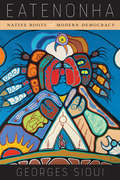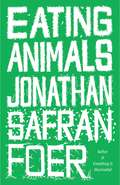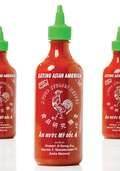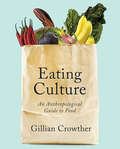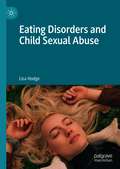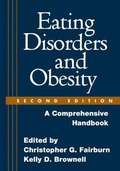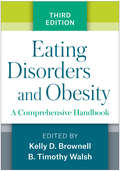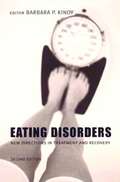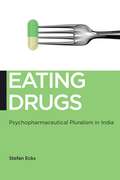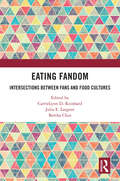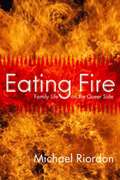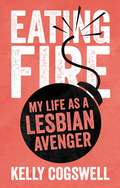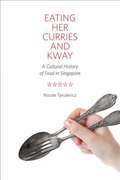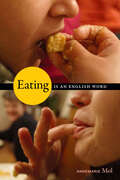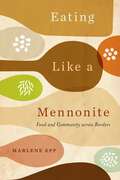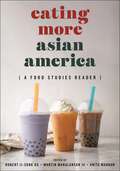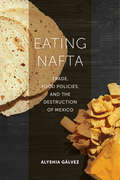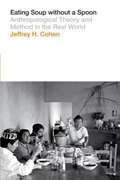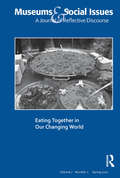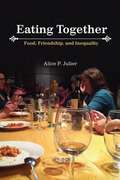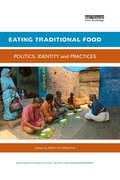- Table View
- List View
Eatenonha: Native Roots of Modern Democracy
by Georges SiouiEatenonha is the Wendat word for love and respect for the Earth and Mother Nature. For many Native peoples and newcomers to North America, Canada is a motherland, an Eatenonha – a land in which all can and should feel included, valued, and celebrated. In Eatenonha Georges Sioui presents the history of a group of Wendat known as the Seawi Clan and reveals the deepest, most honoured secrets possessed by his people, by all people who are Indigenous, and by those who understand and respect Indigenous ways of thinking and living. Providing a glimpse into the lives, ideology, and work of his family and ancestors, Sioui weaves a tale of the Wendat's sparsely documented historical trajectory and his family's experiences on a reserve. Through an original retelling of the Indigenous commercial and social networks that existed in the northeast before European contact, the author explains that the Wendat Confederacy was at the geopolitical centre of a commonwealth based on peace, trade, and reciprocity. This network, he argues, was a true democracy, where all beings of all natures were equally valued and respected and where women kept their place at the centre of their families and communities. Identifying Canada's first civilizations as the originators of modern democracy, Eatenonha represents a continuing quest to heal and educate all peoples through an Indigenous way of comprehending life and the world.
Eatenonha: Native Roots of Modern Democracy
by Georges SiouiEatenonha is the Wendat word for love and respect for the Earth and Mother Nature. For many Native peoples and newcomers to North America, Canada is a motherland, an Eatenonha - a land in which all can and should feel included, valued, and celebrated. In Eatenonha Georges Sioui presents the history of a group of Wendat known as the Seawi Clan and reveals the deepest, most honoured secrets possessed by his people, by all people who are Indigenous, and by those who understand and respect Indigenous ways of thinking and living. Providing a glimpse into the lives, ideology, and work of his family and ancestors, Sioui weaves a tale of the Wendat's sparsely documented historical trajectory and his family's experiences on a reserve. Through an original retelling of the Indigenous commercial and social networks that existed in the northeast before European contact, the author explains that the Wendat Confederacy was at the geopolitical centre of a commonwealth based on peace, trade, and reciprocity. This network, he argues, was a true democracy, where all beings of all natures were equally valued and respected and where women kept their place at the centre of their families and communities. Identifying Canada's first civilizations as the originators of modern democracy, Eatenonha represents a continuing quest to heal and educate all peoples through an Indigenous way of comprehending life and the world.
Eating Animals
by Jonathan Safran FoerJonathan Safran Foer spent much of his teenage and college years oscillating between omnivore and vegetarian. But on the brink of fatherhood-facing the prospect of having to make dietary choices on a child's behalf-his casual questioning took on an urgency His quest for answers ultimately required him to visit factory farms in the middle of the night, dissect the emotional ingredients of meals from his childhood, and probe some of his most primal instincts about right and wrong. Brilliantly synthesizing philosophy, literature, science, memoir and his own detective work,Eating Animalsexplores the many fictions we use to justify our eating habits-from folklore to pop culture to family traditions and national myth-and how such tales can lull us into a brutal forgetting. Marked by Foer's profound moral ferocity and unvarying generosity, as well as the vibrant style and creativity that made his previous books,Everything is IlluminatedandExtremely Loud and Incredibly Close, widely loved,Eating Animalsis a celebration and a reckoning, a story about the stories we've told-and the stories we now need to tell.Â
Eating Asian America: A Food Studies Reader
by Anita Mannur Robert Ji-Song Ku Martin F ManalansanExamines the ways our conceptions of Asian American food have been shapedChop suey. Sushi. Curry. Adobo. Kimchi. The deep associations Asians in the United States have with food have become ingrained in the American popular imagination. So much so that contentious notions of ethnic authenticity and authority are marked by and argued around images and ideas of food.Eating Asian America: A Food Studies Reader collects burgeoning new scholarship in Asian American Studies that centers the study of foodways and culinary practices in our understanding of the racialized underpinnings of Asian Americanness. It does so by bringing together twenty scholars from across the disciplinary spectrum to inaugurate a new turn in food studies: the refusal to yield to a superficial multiculturalism that naively celebrates difference and reconciliation through the pleasures of food and eating. By focusing on multi-sited struggles across various spaces and times, the contributors to this anthology bring into focus the potent forces of class, racial, ethnic, sexual and gender inequalities that pervade and persist in the production of Asian American culinary and alimentary practices, ideas, and images. This is the first collection to consider the fraught itineraries of Asian American immigrant histories and how they are inscribed in the production and dissemination of ideas about Asian American foodways.
Eating Chinese
by Lily Cho"Chicken fried rice, sweet and sour pork, and an order of onion rings, please."Chinese restaurants in small town Canada are at once everywhere - you would be hard pressed to find a town without a Chinese restaurant - and yet they are conspicuously absent in critical discussions of Chinese diasporic culture or even in popular writing about Chinese food. In Eating Chinese, Lily Cho examines Chinese restaurants as spaces that define, for those both inside and outside the community, what it means to be Chinese and what it means to be Chinese-Canadian.Despite restrictions on immigration and explicitly racist legislation at national and provincial levels, Chinese immigrants have long dominated the restaurant industry in Canada. While isolated by racism, Chinese communities in Canada were still strongly connected to their non-Chinese neighbours through the food that they prepared and served. Cho looks at this surprisingly ubiquitous feature of small-town Canada through menus, literature, art, and music. An innovative approach to the study of diaspora, Eating Chinese brings to light the cultural spaces crafted by restaurateurs, diners, cooks, servers, and artists.
Eating Culture: An Anthropological Guide To Food
by Gillian CrowtherHumans have an appetite for food, and anthropology—as the study of human beings, their culture, and society—has an interest in the role of food. From ingredients and recipes to meals and menus across time and space, Eating Culture is a highly engaging overview that illustrates the important role that anthropology and anthropologists have played in understanding food. Organized around the sometimes elusive concept of cuisine and the public discourse—on gastronomy, nutrition, sustainability, and culinary skills—that surrounds it, this practical guide to anthropological method and theory brings order and insight to our changing relationship with food.
Eating Culture: An Anthropological Guide to Food, Second Edition
by Gillian CrowtherFrom ingredients and recipes to meals and menus across time and space, this highly engaging overview illustrates the important roles that anthropology and anthropologists play in understanding food and its key place in the study of culture. The new edition, now in full colour, introduces discussions about nomadism, commercializing food, food security, and ethical consumption, including treatment of animals and the long-term environmental and health consequences of meat consumption. New feature boxes offer case studies and exercises to help highlight anthropological methods and approaches, and each chapter includes a further reading section. By considering the concept of cuisine and public discourse, Eating Culture brings order and insight to our changing relationship with food.
Eating Disorders and Child Sexual Abuse
by Lisa HodgeThis book takes up the challenge of examining women’s understandings of eating disorders and child sexual abuse away from a framework focused on pathology. The central argument is that women’s distress is an enactment of their engagement with certain discourses and practices, rather than a reaction triggered by child sexual abuse. Guided by a contemporary feminist framework and Mikhail Bakhtin’s sociological linguistics, to substantiate the argument, women’s own poetry and drawings are used as evidence to develop, support and supplement research findings. The book establishes that an eating disorder is ‘an understandable response’ to sexual trauma and shifts the focus away from ‘a damaged personality’. Even more importantly, it demonstrates that women with eating disorders are using their bodies as a form of resistance to express silenced traumas that remain in the silenced female body. This is an active way of making sense of experiences of child sexual abuse.
Eating Disorders and Obesity, Second Edition
by Christopher G. Fairburn Kelly D. BrownellThis unique handbook presents and integrates virtually all that is currently known about eating disorders and obesity in one authoritative, accessible, and eminently practical volume. From leading international authorities, 112 concise chapters encapsulate the latest information on all pertinent topics, from biological, psychological, and social processes associated with risk, to clinical methods for assessment and intervention. Suggestions for further reading at the end of each chapter replace extended references and enhance the practical value and readability of the volume.
Eating Disorders and Obesity, Third Edition: A Comprehensive Handbook
by Kelly D. Brownell B. Timothy WalshAcclaimed for its encyclopedic coverage, this is the only handbook that synthesizes current knowledge and clinical practices in the fields of both eating disorders and obesity. Like the prior editions, the significantly revised third edition features more than 100 concise, focused chapters with lists of key readings in place of extended references. All aspects of eating disorders and obesity are addressed by foremost clinical researchers: classification, causes, consequences, risk factors, and pathophysiology, as well as prevention, treatment, assessment, and diagnosis. New to This Edition *Reflects 15 years of important advances in both fields, including state-of-the-art intervention approaches and a growing focus on how the brain regulates eating behavior. *Dozens of entirely new chapters. *New topics: epigenetics, body weight and neurocognitive function, stress and emotion regulation, the gut microbiome, surgical devices for obesity, food labeling and marketing, and more. *Expanded coverage of prevention and policy.
Eating Disorders: New Directions in Treatment and Recovery (Issues Ser. #Vol. 127)
by Ed. Kinoy Barbara P.Fully revised to reflect changes in the field, this collection of essays by psychotherapists who specialize in the treatment of anorexia nervosa and bulimia explains in accessible and humane terms how the treatment process works and demonstrates strategies that lead to recovery. The book details the interaction between practitioner and patient, practitioner and practitioner, and family members. The collection, which draws upon the knowledge and experience of clinicians who have practiced at the Wilkins Center for Eating Disorders, also points up the advantages of a collaborative team, for both the patient and professionals.
Eating Disorders: New Directions in Treatment and Recovery, Second Edition
by Barbara P. KinoyFully revised to reflect changes in the field, this collection of essays by psychotherapists details the interaction between practitioner and patient, practitioner and practitioner, and family members.
Eating Drugs: Psychopharmaceutical Pluralism in India (Biopolitics #20)
by Stefan EcksA Hindu monk in Calcutta refuses to take his psychotropic medications. His psychiatrist explains that just as his body needs food, the drugs are nutrition for his starved mind. Does it matter how—or whether—patients understand their prescribed drugs? Millions of people in India are routinely prescribed mood medications. Pharmaceutical companies give doctors strong incentives to write as many prescriptions as possible, with as little awkward questioning from patients as possible. Without a sustained public debate on psychopharmaceuticals in India, patients remain puzzled by the notion that drugs can cure disturbances of the mind. While biomedical psychopharmaceuticals are perceived with great suspicion, many non-biomedical treatments are embraced. Stefan Ecks illuminates how biomedical, Ayurvedic, and homeopathic treatments are used in India, and argues that pharmaceutical pluralism changes popular ideas of what drugs do. Based on several years of research on pharmaceutical markets, Ecks shows how doctors employ a wide range of strategies to make patients take the remedies prescribed. Yet while metaphors such as "mind food" may succeed in getting patients to accept the prescriptions, they also obscure a critical awareness of drug effects.This rare ethnography of pharmaceuticals will be of key interest to those in the anthropology and sociology of medicine, pharmacology, mental health, bioethics, global health, and South Asian studies.
Eating Fandom: Intersections Between Fans and Food Cultures
by CarrieLynn D. Reinhard, Julia E. Largent, and Bertha ChinThis book considers the practices and techniques fans utilize to interact with different aspects and elements of food cultures. With attention to food cultures across nations, societies, cultures, and historical periods, the collected essays consider the rituals and values of fan communities as reflections of their food culture, whether in relation to particular foods or types of food, those who produce them, or representations of them. Presenting various theoretical and methodological approaches, the anthology brings together a series of empirical studies to examine the intersection of two fields of cultural practice and will appeal to sociologists, geographers and scholars of cultural studies with interests in fan studies and food cultures.
Eating Fire: Family Life on the Queer Side
by Michael RiordonEating Fire follows in the steps of Riordon’s popular 1996 book Out our way, on gay and lesbian life in the country (BTL, 1996). This new set of tales examines the range in living patterns and relationships among queer families across Canada. Eating Fire illuminates the rich diversity in which people negotiate their personal and public identities. As in all his writing and radio work, Riordon brings to this book a subtle, direct, and vivid style. For Eating Fire he travelled widely, engaging in significant new research and speaking with hundreds of fascinating people. The resulting book is wanted and needed in classrooms, within queer communities, and among everyone hungry for knowledge about the wide range of Canadian families.
Eating Fire: My Life as a Lesbian Avenger
by Kelly J. CogswellWhen Kelly Cogswell plunged into New York&’s East Village in 1992, she had just come out. An ex–Southern Baptist born in Kentucky, she was camping in an Avenue B loft, scribbling poems, and playing in an underground band, trying to figure out her next move. A couple of months later she was consumed by the Lesbian Avengers, instigating direct action campaigns, battling cops on Fifth Avenue, mobilizing 20,000 dykes for a march on Washington, D.C., and eating fire—literally—in front of the White House.At once streetwise and wistful, Eating Fire is a witty and urgent coming-of-age memoir spanning two decades, from the Culture War of the early 1990s to the War on Terror. Cogswell&’s story is an engaging blend of picaresque adventure, how-to activist handbook, and rigorous inquiry into questions of identity, resistance, and citizenship. It is also a compelling, personal recollection of friendships and fallings-out and of finding true love—several times over. After the Lesbian Avengers imploded, Cogswell describes how she became a pioneering citizen journalist, cofounding the Gully online magazine with the groundbreaking goal of offering &“queer views on everything.&”The first in-depth account of the influential Lesbian Avengers, Eating Fire reveals the group&’s relationship to the queer art and activist scene in early &’90s New York and establishes the media-savvy Avengers as an important precursor to groups such as Occupy Wall Street and La Barbe, in France. A rare insider&’s look at the process and perils of street activism, Kelly Cogswell&’s memoir is an uncompromising and ultimately empowering story of creative resistance against hatred and injustice.
Eating Her Curries and Kway: A Cultural History of Food in Singapore
by Nicole TaruleviczWhile eating is a universal experience, for Singaporeans it carries strong national connotations. The popular Singaporean-English phrase "Die die must try" is not so much hyperbole as it is a reflection of the lengths that Singaporeans will go to find great dishes. <P><P> In Eating Her Curries and Kway: A Cultural History of Food in Singapore, Nicole Tarulevicz argues that in a society that has undergone substantial change in a relatively short amount of time, food serves Singaporeans as a poignant connection to the past. Covering the period from British settlement in 1819 to the present and focusing on the post-1965 postcolonial era, Tarulevicz tells the story of Singapore through the production and consumption of food. <P><P> Analyzing a variety of sources that range from cookbooks to architectural and city plans, Tarulevicz offers a thematic history of this unusual country, which was colonized by the British and operated as a port within Malaya, but which is without a substantial pre-colonial history. <P><P>Connecting food culture to the larger history of Singapore, she discusses various topics including domesticity and home economics, housing and architecture, advertising, and the regulation of food-related manners and public behavior such as hawking, littering, and chewing gum. <P><P>Moving away from the predominantly political and economic focus of other histories of Singapore, Tarulevicz provides an important alternative reading of Singaporean society.
Eating Is an English Word
by Annemarie MolEating is generally understood as a human need that people satisfy in diverse ways. Eating, however, is also an English word. Other languages, using other words, order reality differently: they may fuse eating with breathing, or distinguish chupar from comer. Anthropologists flag such differences by leaving a few of their words untranslated, but what language do we think in? This isn’t necessarily English. We may be linguistically closer to those whose practices we study: them. Against this background, Eating Is an English Word argues that social scientists should let go of the dream of universal concepts. Our analytical terms had better vary. Annemarie Mol and her coauthors exemplify this in a series of material semiotic inquiries into eating practices. They employ terms like lekker, tasting with fingers, chupar, schmecka, gustar, and settling on an okay meal to explore appreciative modes of valuing. Welcome, then, to spirited stories about satisfied stomachs, love for a lamb, juicy fruit treats, and companionable lunches and dinners.
Eating Like a Mennonite: Food and Community across Borders
by Marlene EppMennonites are often associated with food, both by outsiders and by Mennonites themselves. Eating in abundance, eating together, preserving food, and preparing so-called traditional foods are just some of the connections mentioned in cookbooks, food advertising, memoirs, and everyday food talk. Yet since Mennonites are found around the world – from Europe to Canada to Mexico, from Paraguay to India to the Democratic Republic of the Congo – what can it mean to eat like one?In Eating Like a Mennonite Marlene Epp finds that the answer depends on the eater: on their ancestral history, current home, gender, socio-economic position, family traditions, and personal tastes. Originating in central Europe in the sixteenth century, Mennonites migrated around the world even as their religious teachings historically emphasized their separateness from others. The idea of Mennonite food became a way of maintaining community identity, even as unfamiliar environments obliged Mennonites to borrow and learn from their neighbours. Looking at Mennonites past and present, Epp shows that foodstuffs (cuisine) and foodways (practices) depend on historical and cultural context. She explores how diets have evolved as a result of migration, settlement, and mission; how food and gender identities relate to both power and fear; how cookbooks and recipes are full of social meaning; how experiences and memories of food scarcity shape identity; and how food is an expression of religious beliefs – as a symbol, in ritual, and in acts of charity.From zwieback to tamales and from sauerkraut to spring rolls, Eating Like a Mennonite reveals food as a complex ingredient in ethnic, religious, and personal identities, with the ability to create both bonds and boundaries between people.
Eating More Asian America: A Food Studies Reader
by Anita Mannur Robert Ji-Song Ku Martin F. Manalansan, IVThe diversity of Asian American food cultureAsian American-inspired foods are everywhere—or so it seems. A decade ago, chop suey, sushi, curry, adobo, and kimchi were emblematic of Asian American culinary influence. Today, boba, ube, bibingka, phở, matcha, gochujang, and málà have joined the roster of foods strongly associated with Asian Americans. These foods were once considered exotic but now are embraced by mainstream culture.Food studies continues to be an appetizing area of Asian American studies. Eating More Asian America is a follow-up to the influential Eating Asian America, and it provides a rich illustration of the intersection of Asian America and its various foodways. The book posits that food is never simply sustenance—the comestible material that provides fuel for our bodies. Rather, food is a way of knowing, a way of being, and a way of understanding. The essays in Eating More Asian America convey the intellectual richness of various foodways as they intersect with and inform the racial and political construct known as “Asian America.”The twenty-one essays in this volume reflect the diversity of Asian America itself as well as the subfield of food studies. The volume not only offers coverage in terms of topics and types of ethnic food, it also provides a rich and impressive array of methodological approaches. A veritable feast for the senses, Eating More Asian America explores the myriad ways critical eating studies has developed over the past decade.
Eating NAFTA: Trade, Food Policies, and the Destruction of Mexico
by Alyshia GálvezMexican cuisine has emerged as a paradox of globalization. Food enthusiasts throughout the world celebrate the humble taco at the same time that Mexicans are eating fewer tortillas and more processed food. Today Mexico is experiencing an epidemic of diet-related chronic illness. The precipitous rise of obesity and diabetes—attributed to changes in the Mexican diet—has resulted in a public health emergency. In her gripping new book, Alyshia Gálvez exposes how changes in policy following NAFTA have fundamentally altered one of the most basic elements of life in Mexico—sustenance. Mexicans are faced with a food system that favors food security over subsistence agriculture, development over sustainability, market participation over social welfare, and ideologies of self-care over public health. Trade agreements negotiated to improve lives have resulted in unintended consequences for people’s everyday lives.
Eating Soup without a Spoon: Anthropological Theory and Method in the Real World
by Jeffrey H. CohenSignificant scholarship exists on anthropological fieldwork and methodologies. Some anthropologists have also published memoirs of their research experiences. Renowned anthropologist Jeffrey Cohen's Eating Soup without a Spoon is a first-of-its-kind hybrid of the two, expertly melding story with methodology to create a compelling narrative of fieldwork that is deeply grounded in anthropological theory. Cohen's first foray into fieldwork was in 1992, when he lived in Santa Anna del Valle in rural Oaxaca, Mexico. While recounting his experiences studying how rural folks adapted to far-reaching economic changes, Cohen is candid about the mistakes he made and the struggles in the village. From the pressures of gaining the trust of a population to the fear of making errors in data collection, Cohen explores the intellectual processes behind ethnographic research. He offers tips for collecting data, avoiding pitfalls, and embracing the chaos and shocks that come with working in an unfamiliar environment. Cohen's own photographs enrich his vivid portrayals of daily life. In this groundbreaking work, Cohen discusses the adventure, wonder, community, and friendships he encountered during his first year of work, but, first and foremost, he writes in service to the field as a place to do research: to test ideas, develop theories, and model how humans cope and react to the world.
Eating Together in Our Changing World: Museums & Social Issues 7:1 Thematic Issue (Museums & Social Issues)
by Kris Morrissey Emily SparlingFirst Published in 2012. Routledge is an imprint of Taylor & Francis, an Informa company.
Eating Together: Food, Friendship and Inequality
by Alice P. JulierAn insightful map of the landscape of social meals, Eating Together: Food, Friendship, and Inequality argues that the ways in which Americans eat together play a central role in social life in the United States. Delving into a wide range of research, Alice P. Julier analyzes etiquette and entertaining books from the past century and conducts interviews and observations of dozens of hosts and guests at dinner parties, potlucks, and buffets. She finds that when people invite friends, neighbors, or family members to share meals within their households, social inequalities involving race, economics, and gender reveal themselves in interesting ways: relationships are defined, boundaries of intimacy or distance are set, and people find themselves either excluded or included.
Eating Traditional Food: Politics, identity and practices (Routledge Studies in Food, Society and the Environment)
by Brigitte SebastiaDue to its centrality in human activities, food is a meaningful object that necessarily participates in any cultural, social and ideological construction and its qualification as 'traditional' is a politically laden value. This book demonstrates that traditionality as attributed to foods goes beyond the notions of heritage and authenticity under which it is commonly formulated. Through a series of case studies from a global range of cultural and geographical areas, the book explores a variety of contexts to reveal the complexity behind the attribution of the term 'traditional' to food. In particular, the volume demonstrates that the definitions put forward by programmes such as TRUEFOOD and EuroFIR (and subsequently adopted by organisations including FAO), which have analysed the perception of traditional foods by individuals, do not adequately reflect this complexity. The concept of tradition being deeply ingrained culturally, socially, politically and ideologically, traditional foods resist any single definition. Chapters analyse the processes of valorisation, instrumentalisation and reinvention at stake in the construction and representation of a food as traditional. Overall the book offers fresh perspectives on topics including definition and regulation, nationalism and identity, and health and nutrition, and will be of interest to students and researchers of many disciplines including anthropology, sociology, politics and cultural studies.
